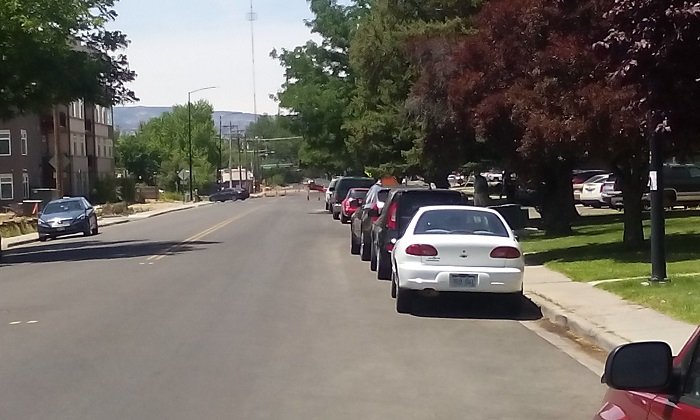
Bookcliff Avenue looking west toward 7th Street from 9th Street, showing a portion of the route followed by the Little Book Cliff Railway.
Bookcliff Avenue seems an obvious enough name. You would think that it was named, of course, for the Bookcliffs, our rugged desert mountains to the north of town, but this is only indirectly the case. Bookcliff Avenue seems to have been named instead for a railroad that once ran along part of its length on its way to the Bookcliffs.
William Thomas Carpenter began building The Little Book Cliff Railway in 1889 in order to transport coal from the Book Cliff Coal Mine. Once it opened in 1890, the railroad also transported people on pleasure excursions northeast of Grand Junction to the town of Carpenter (now a ghost town).
According to Lyndon J. Lampert (as noted in both his lecture and his book Little Book Cliff Railway: The Life and Times of a Colorado Narrow Gauge), the train ran from the Little Book Cliff Railway Depot near the intersection of Rice Street and Main Street, went north on 1st Street toward First Fruitridge, crossed the Mesa County Ditch, went due east south of what were then the Mesa County Fairgrounds, and then northeast through orchards and onto the Bookcliffs.
According to Dudley W. Mitchell, a frequent Mesa County Oral History Project interviewee, a longtime employee of the Denver & Rio Grande Railroad, a railroad history buff and one-time employee of the Little Book Cliff Railway (unloading coal cars by shovel), the train partially followed what we now know as Bookcliff Avenue and then Little Bookcliff Drive, east and northeast out of town. By following Lampert’s description and a map for the Little Book Cliff Railway included in the back of his book (which cannot be reproduced here, unfortunately) and comparing it to a modern map of Grand Junction’s streets, you can see that the path of the railway follows the trajectory of Bookcliff Avenue and Little Bookcliff Drive, bringing Lampert and Mitchell’s narratives together.
See Ike’s excellent Mesa County Libraries blogs about the Little Book Cliff Railway and the town of Carpenter to learn about other landmarks that coincide with the railroad. For more information about the Little Book Cliff Railway and other local railroads, search the Mesa County Oral History Project and our Local Digital Archive.
